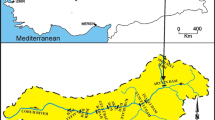Abstract
Geotechnical investigation projects in Korea produced data on the in situ modulus of deformation of rock masses (E M) measured with the borehole test, rock mass rating (RMR), and Q-system. The modulus of deformation of rock masses was correlated with the degree of weathering, RMR, and Q values. Determination of E M for each degree of weathering allows for the results to be used to classify the degree of weathering or to predict E M. The relation between E M and RMR is represented by \( E_{\text{M}} = 10^{{\frac{{{\text{RMR}} - 16}}{50}}} \), which returns values 2–3 times lower than those reported in previous studies. Despite scatter in the values, due to larger dataset used in this study, the proposed equation may be used to predict the in situ modulus of deformation from RMR values. In addition, the relation between modulus of deformation and Q values is \( E_{\text{M}} = 10^{{0.32{ \log }Q + 0.585}} \).






Similar content being viewed by others
References
Ahn T (2011) The correlation between RMR and deformation modulus by rock masses using pressuremeter. Korean Geoenviron Soc 12:5–12 (in Korean)
Aydan Ö, Kawamoto T (2000) Assessing mechanical properties of rock masses by RMR rock classification method. GeoEng 2000 Symposium, Sydney, OA0926
Aydan Ö, Ulusay R, Kawamoto T (1997) Assessment of rock mass strength for underground excavations. Th 36th US Rock Mechanics Symposium, pp 777–786
Barton N, Loset F, Lien R, Lune J (1980) Application of Q-system in design decisions concerning dimensions and appropriate support for underground installations. Subsurface Space, Pergamon, pp 553–561
Bieniawski ZT (1978) Determining rock mass deformability: experience from case histories. Int J Rock Mech Min Sci Geomech Abstr 15:237–247
Chun B-S, Jung S-H, Lee Y-J, Ahn K-C, Shin J-K (2006a) An evaluation of empirical prediction equation for deformation modulus of rock masses by field measurements. J Korean Soc Rock Mech Tunn Undergr Space 16:251–258 (in Korean)
Chun B-S, Lee Y-J, Jung S-H (2006b) The evaluation for estimation method of deformation modulus of rock mass using RMR system. Korean Geoenviron Soc 7:25–32 (in Korean)
Hoek E, Brown ET (1997) Practical estimation of rock mass strength. Int J Rock Mech Min Sci 34:1165–1186
Hoek E, Carranza-Torres C, Corkum B (2002) Hoek-Brown failure criterion—2002 Edition. Proceedings of the 5th North American Rock Mechanics Symposium, Toronto, July 2002, 267–273
International society for rock mechanics (1975) Report of the commission on terminology, Lisbon
Kim G (1993) Revaluation of geomechanics classification of rock mass. Geotechnical Engineering and Tunneling Technology, Korean Geotechnical Society Spring ‘93 National Conference, Seoul, Korea, pp 33–40 (in Korean)
Kim G (1996) Manual for site investigation. Seoul, p 123 (in Korean)
Kim D-S, Park S-Y, Kim S-I (2008) Evaluation of correlation between subgrade reaction modulus and strain modulus using plate loading test. Korean Geotech Soc 24:57–67 (in Korean)
Korean Society for Rock Mechanics (1999) Techniques of site investigation and testing for civil engineers. Rock Mechanics Technical Report, p 799 (in Korean)
Park Y-B, Chung H-S (2003) A comparison of static and dynamic deformation modulus by dynamic plate test. Korean Geotech Soc 19:335–342 (in Korean)
Rocha M (1974) Present possibilities of studying foundations of concrete dams. Proceedings of 3rd Congress on Rock mechanics. Int Soc Rock Mech Denver 1A:879–896
Rocha M, Da Silva JN (1970) A new method for determination of deformability of rock masses. Proceedings of 2nd Congress on Rock mechanics, International Society for Rock mechanics, Belgrade, pp 2–21
Serafim JL, Pereira JP (1983) Consideration on the geomechanics classification of Bieniawski. International Symposium on Engineering Geology and Underground Construction, LNEC, Lisbon, 1: 33–42
Author information
Authors and Affiliations
Corresponding author
Rights and permissions
About this article
Cite this article
Kang, SS., Kim, HY. & Jang, BA. Correlation of in situ modulus of deformation with degree of weathering, RMR and Q-system. Environ Earth Sci 69, 2671–2678 (2013). https://doi.org/10.1007/s12665-012-2088-y
Received:
Accepted:
Published:
Issue Date:
DOI: https://doi.org/10.1007/s12665-012-2088-y




